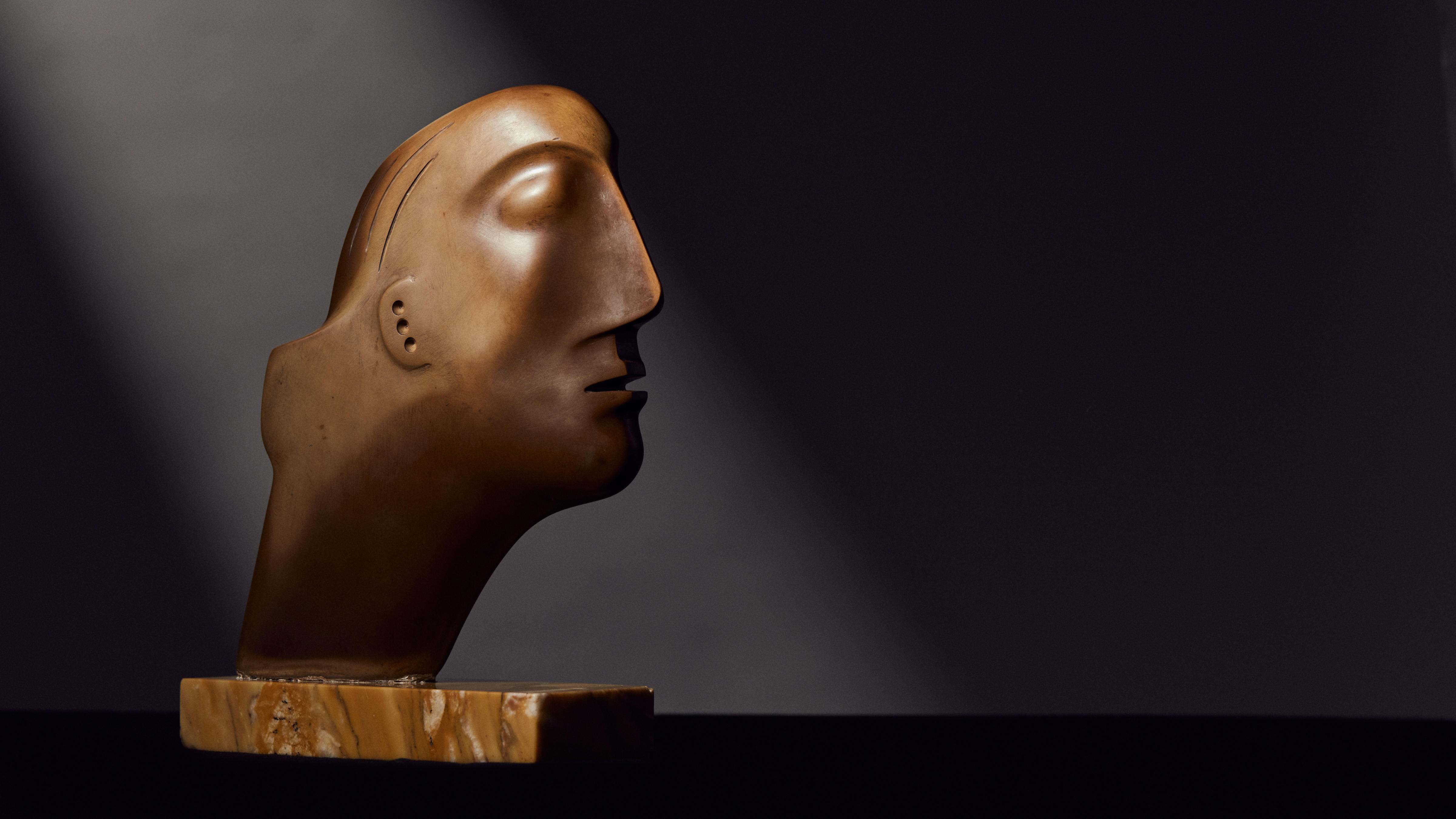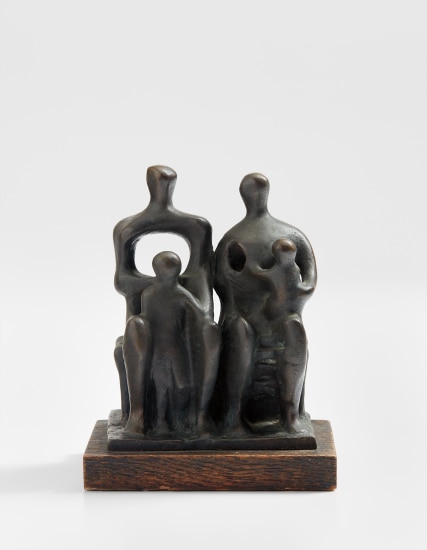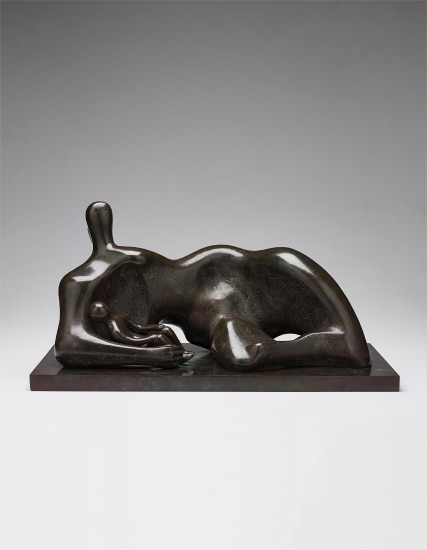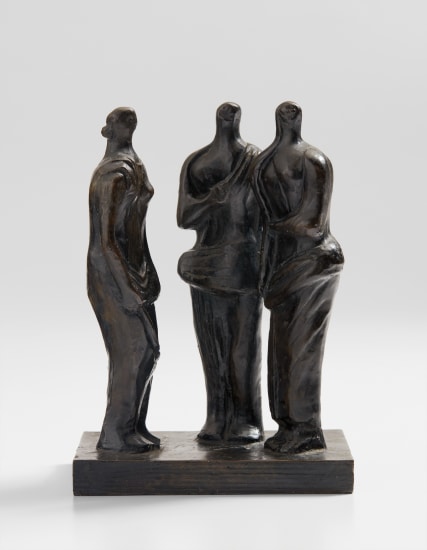6 The Modern Form: Property from the Collection of Betty and Stanley Sheinbaum Henry Moore Follow Family Group bronze with brown patina, on wood base sculpture 15.6 x 14.6 x 8.3 cm (6 1/8 x 5 3/4 x 3 1/4 in.) base 1.9 x 16.8 x 9.5 cm (3/4 x 6 5/8 x 3 3/4 in.) overall 17.5 x 16.8 x 9.5 cm (6 7/8 x 6 5/8 x 3 3/4 in.) Executed in 1944, this work is from an edition of 11 plus 1 artist's proof. This work is recorded in the archives of the Henry Moore Foundation.
Provenance Continental Fine Arts (Eric Estorick), New York (acquired directly from the artist) Acquired from the above by the family of the present owner in 1958 Exhibited Los Angeles County Museum of Art, Henry Moore in Southern California, 2 October - 18 November 1973, no. 16 (present lot exhibited) Literature Robert Melville, Henry Moore Sculpture and Drawings 1921-1969 , London, 1970, no. 321, pp. 349, 351 (another example illustrated) David Sylvester ed., Henry Moore Complete Sculpture 1921-48 , vol. 1, London, 1990, no. 232, p. 14 (another example illustrated, erroneously catalogued as from an edition of 9, p. 145) Catalogue Essay Henry Moore’s Family Group encapsulates one of the most recognisable subjects in art from the 20th century; the sculptor’s depiction of the family remains an enduring and universal motif of warmth and tenderness. Executed in 1944, the theme of Family Group has come to represent one of Moore’s earliest sculptural triumphs, demonstrating his unrivalled mastery of tension, vitality and intimacy, captured exquisitely in bronze. With another edition of the present cast held in the Museum Ludwig Collection, Cologne, Moore’s monumental family group configurations are housed in some of the world’s seminal public and private collections, namely Tate London, the Museum of Modern Art, New York and in the collection of Nelson D. Rockefeller. Depicting a family of two adults and two children, Moore’s harmonious composition of four figures is charged with a familiar vitality, which connects all members of the bronze group. A key collector of progressive and thought-provoking works, Betty Sheinbaum purchased Family Group from esteemed dealer, Eric Estorick, in 1958. The present work not only demonstrates Moore’s exquisite craftsmanship as a modern master, but also incorporates a sense of both progressive optimism and retrospective criticism which prevailed in the US and Britain after the Second World War. Moore’s Family Group depicts the tenderness developed in the artist’s Mother and Child compositions; his experimentations with this theme hail from his earlier abstract depictions of maternal closeness. Influenced by Bellini on his travels to Italy, visual impressions of Moore’s sculpture of Madonna and Child, 1943 – 1944, housed in St Matthew’s Church, Northampton, are evident in the embrace of the mother figure in the present work, her arms cradling her baby in a maternal clasp. The father figure and the smaller child reading a book convey the nurturing relationship between the didactic father and innocent child. Conveying a paternal and instructive authority over the little figure, the naivety of the scene suspends the viewer in a nostalgic and evocative moment of reflective meditation. In 1944, Moore was yet to become a father, however this theme would develop in his oeuvre following the birth of his daughter. As Harry Seldis states, ‘In every way 1946 was a miraculous year for Henry Moore On March 7, 1946, his daughter was born and named Mary after his mother and sister. The artist was forty-seven years old, his wife, Irina was thirty nine. Many of the most playful and tender works in Moore’s over-all oeuvre were inspired by this happy event’ (Harry Seldis, quoted in Henry Moore in America , Los Angeles, 1973, p. 72). Appealing to a new humanitarian hopefulness in the wake of the Second World War, Moore’s sculpture captures a sense of progressive and collective humanism; his work promoted man’s relationship to nature through his organic shapes, whilst his celebrated Shelter Drawings encapsulated the tender resolve of the family unit which clung together through the darkness of wartime, to emerge into the light of a world left shattered by the devastating effects of conflict. Moving to London to capture the tenacious spirit of Londoners during the Blitz, Moore was appointed the position of the official war artist by Kenneth Clark In London, Moore formulated his composition for the Family Group sculp
6 The Modern Form: Property from the Collection of Betty and Stanley Sheinbaum Henry Moore Follow Family Group bronze with brown patina, on wood base sculpture 15.6 x 14.6 x 8.3 cm (6 1/8 x 5 3/4 x 3 1/4 in.) base 1.9 x 16.8 x 9.5 cm (3/4 x 6 5/8 x 3 3/4 in.) overall 17.5 x 16.8 x 9.5 cm (6 7/8 x 6 5/8 x 3 3/4 in.) Executed in 1944, this work is from an edition of 11 plus 1 artist's proof. This work is recorded in the archives of the Henry Moore Foundation.
Provenance Continental Fine Arts (Eric Estorick), New York (acquired directly from the artist) Acquired from the above by the family of the present owner in 1958 Exhibited Los Angeles County Museum of Art, Henry Moore in Southern California, 2 October - 18 November 1973, no. 16 (present lot exhibited) Literature Robert Melville, Henry Moore Sculpture and Drawings 1921-1969 , London, 1970, no. 321, pp. 349, 351 (another example illustrated) David Sylvester ed., Henry Moore Complete Sculpture 1921-48 , vol. 1, London, 1990, no. 232, p. 14 (another example illustrated, erroneously catalogued as from an edition of 9, p. 145) Catalogue Essay Henry Moore’s Family Group encapsulates one of the most recognisable subjects in art from the 20th century; the sculptor’s depiction of the family remains an enduring and universal motif of warmth and tenderness. Executed in 1944, the theme of Family Group has come to represent one of Moore’s earliest sculptural triumphs, demonstrating his unrivalled mastery of tension, vitality and intimacy, captured exquisitely in bronze. With another edition of the present cast held in the Museum Ludwig Collection, Cologne, Moore’s monumental family group configurations are housed in some of the world’s seminal public and private collections, namely Tate London, the Museum of Modern Art, New York and in the collection of Nelson D. Rockefeller. Depicting a family of two adults and two children, Moore’s harmonious composition of four figures is charged with a familiar vitality, which connects all members of the bronze group. A key collector of progressive and thought-provoking works, Betty Sheinbaum purchased Family Group from esteemed dealer, Eric Estorick, in 1958. The present work not only demonstrates Moore’s exquisite craftsmanship as a modern master, but also incorporates a sense of both progressive optimism and retrospective criticism which prevailed in the US and Britain after the Second World War. Moore’s Family Group depicts the tenderness developed in the artist’s Mother and Child compositions; his experimentations with this theme hail from his earlier abstract depictions of maternal closeness. Influenced by Bellini on his travels to Italy, visual impressions of Moore’s sculpture of Madonna and Child, 1943 – 1944, housed in St Matthew’s Church, Northampton, are evident in the embrace of the mother figure in the present work, her arms cradling her baby in a maternal clasp. The father figure and the smaller child reading a book convey the nurturing relationship between the didactic father and innocent child. Conveying a paternal and instructive authority over the little figure, the naivety of the scene suspends the viewer in a nostalgic and evocative moment of reflective meditation. In 1944, Moore was yet to become a father, however this theme would develop in his oeuvre following the birth of his daughter. As Harry Seldis states, ‘In every way 1946 was a miraculous year for Henry Moore On March 7, 1946, his daughter was born and named Mary after his mother and sister. The artist was forty-seven years old, his wife, Irina was thirty nine. Many of the most playful and tender works in Moore’s over-all oeuvre were inspired by this happy event’ (Harry Seldis, quoted in Henry Moore in America , Los Angeles, 1973, p. 72). Appealing to a new humanitarian hopefulness in the wake of the Second World War, Moore’s sculpture captures a sense of progressive and collective humanism; his work promoted man’s relationship to nature through his organic shapes, whilst his celebrated Shelter Drawings encapsulated the tender resolve of the family unit which clung together through the darkness of wartime, to emerge into the light of a world left shattered by the devastating effects of conflict. Moving to London to capture the tenacious spirit of Londoners during the Blitz, Moore was appointed the position of the official war artist by Kenneth Clark In London, Moore formulated his composition for the Family Group sculp
.jpg)


.jpg)


.jpg)
.jpg)







Try LotSearch and its premium features for 7 days - without any costs!
Be notified automatically about new items in upcoming auctions.
Create an alert